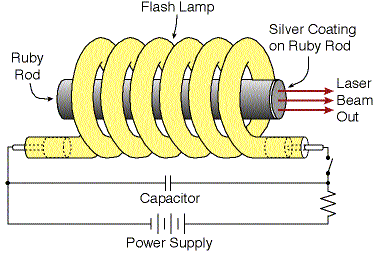Rami Arieli: "The
Laser Adventure" Section 6.2.1 page 4
Ruby - The first Laser
The Ruby laser is a laser which operate in a very narrow range of parameters.
The Ruby laser is a three level laser,
and it is a surprise that it was the first man made lasers in history.
As a matter of fact, right after the first published article of Townes
and Schawlow on the feasibility of lasing in the visible spectrum, many
research laboratories started an effort to create the first laser.
The common assumption was that optical pumping is inefficient
because they were thinking of gasses, and as explained before, the width
of spectral absorption in gasses is very narrow. They thought that pumping
with a broad band source such as flash lamp, would be very inefficient,
since most of the excitation energy would not be absorbed, and population
inversion would not be achieved.
Small Ruby rods are with diameter
of about 6 [mm], and length of about 7 [cm].
The biggest rods can be up to 20
[mm] in diameter, and 20 [cm] in length.
In figure 6.14 a schematic description of the first Ruby laser developed
by Theodore Maiman.
 Figure 6.14: Schematic Description of the First
Ruby Laser
Figure 6.14: Schematic Description of the First
Ruby Laser
Since the Ruby crystal is a jewel, the story is that Maimanís wife was
wearing it on her neck when they came to conferences.

